
* The introduction of jet propulsion during World War II led to efforts to develop a jet airliner in the postwar period. The British were pioneers, developing the ground-breaking "de Havilland Comet" -- but the lead obtained by the Comet in the jetliner business was lost when the aircraft ran into unforeseen and deadly technical difficulties. The French were more fortunate with the subsequent "Caravelle" jetliner, an elegant machine that pointed the way to a new generation of jetliners. This document provides a history and description of the Comet and Caravelle. A list of illustration credits is included at the end.
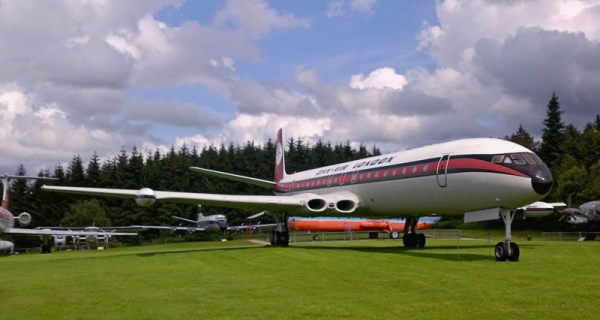
* In 1943, as it became apparent that the Allies were going to win World War II, the British government appointed a committee under Lord Brabazon to consider plans for the postwar commercial aviation industry. The Americans were supplying the bulk of transport capability for the Allied war effort, most particularly in the form of the Douglas DC-3 / C-47 Dakota, and there were worries that once the fighting was over the Americans would dominate commercial aircraft sales while the UK scrambled to catch up.
Late in the year the committee issued a set of recommendations defining four, later five, different transport types. One of the more foresighted of the recommendations was the "Type IV", a jet-powered airliner, a notion that few elsewhere were thinking about at the time. The Type IV had been pushed by committee member Sir Geoffrey de Havilland, boss of the de Havilland aircraft firm. The five different airliner projects were tasked out to different British aviation firms for more detailed consideration, with the Type IV of course going to de Havilland.
Following the end of the war, in February 1945 de Havilland was authorized to come up with a detailed proposal for the Type IV, with the company designating their concept the "DH.106". In September 1946, the Ministry of Supply ordered two prototypes; by late 1947, an engineering team under the direction of Ronald Bishop -- chief designer of the de Havilland Mosquito fighter-bomber -- had sorted through a range of configurations to come up with a finalized design. The British Overseas Airways Corporation (BOAC) placed an order for nine machines. The aircraft was given the name "Comet".
The initial flight of the first Comet prototype took place on 27 July 1949, with well-known test pilot John Cunningham at the controls. The aircraft was displayed at the 1949 Farnborough air show. The second prototype performed its initial flight in 1950. The second prototype was passed on to BOAC the next year as a training and route proving machine. The first production "Comet 1" machine performed its initial flight on January 1951, with the type receiving certification a year later.
The Comet's first official fare-carrying flight -- the first such of a jet airliner -- was on 9 May 1952, involving a flight from London to Johannesburg, South Africa. It required five stops -- Rome, Khartoum (in Sudan), Entebbe (in Uganda), and Livingstone (in Zambia, a tourist stop for Victoria Falls) -- but the trip took less than 24 hours. The world had just shrunk in half.
* The Comet 1 was of all-metal construction, with a wing featuring a leading-edge sweep of 20 degrees, straight tail surfaces, and tricycle landing gear. It was powered by four de Havilland Ghost 50 Mark 1 centrifugal-flow turbojets, buried in the wing roots, with 22.5 kN (2,290 kgp / 5,050 lbf) thrust each.
The wing had three spars. Wing flight control surface arrangement was conventional, with flaps, ailerons, and airbrakes ahead of the flaps, plus a wing fence outboard on each wing to keep airflow from passing down the wing to the wingtips. The wing was loaded with fuel tanks, giving a capacity of 27,503 liters (7,257 US gallons) -- even with that, early jet engines were guzzlers and the Comet was incapable of nonstop trans-Atlantic service.
The nose gear had twin wheels while the main gear had four wheels each, in a 2x2 bogie configuration. The landing gear featured hydraulic retraction; nose gear retracted backwards, while each main gear assembly retracted outwards into a bulge under the wing. The prototypes had started life with single-wheel main gear, but all production Comets had the 2x2 bogies. There was a bumper under the tail to deal with tail scrapes.
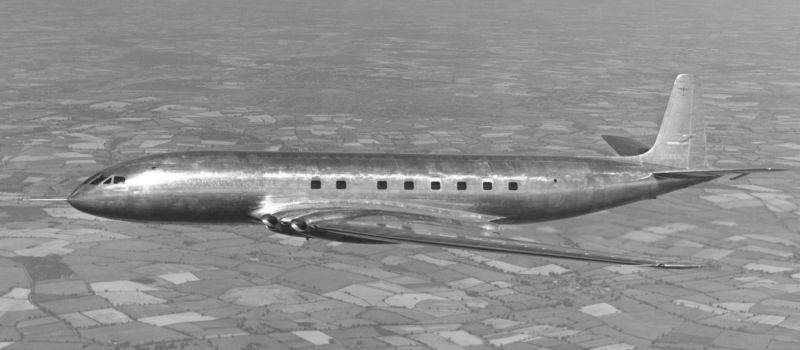
The engine configuration reduced drag and made the aircraft easier to handle under engine-out conditions, permitting a smaller fin and rudder. Compared to modern jetliner podded engines, the Comet's relatively high-mounted engine arrangement also reduced the threat of foreign object ingestion on take-offs and landings. The disadvantages were that service access to the engines was more troublesome, and that firewalls had to be installed to prevent the destruction of one engine from taking out the engine next to it, increasing weight. The design included a de Havilland Sprite liquid-fuel rocket motor between the engines on both sides for additional take-off thrust in "hot and high" conditions; the Sprites were trialed, but never used in service.
Flight crew included pilot and copilot, navigator, and flight engineer. The Comet 1 featured 36 seats in a four-across format, of course in a pressurized cabin. Pressure was maintained at a substantially higher level than had been practice before, with the pressurization provided by engine bleed air, bleed air also being used to de-ice the wings and tail. The original passenger windows were rectangular, a detail that would prove far more significant than anyone expected. There was a passenger door on the left rear fuselage, a service door on the front right fuselage, and two emergency exits on each side of the fuselage -- one at the front of the wing, one near the rear.
There was a baggage room behind the cockpit, there being no room under the floor for baggage, plus a galley and two washrooms. Life rafts were stowed in the wings near the engines. Overall, the Comet incorporated a wide range of leading-edge features, and de Havilland put the machine through extensive trials to ensure that it all worked properly. As it turned out, the trials weren't extensive enough.
BACK_TO_TOP* The Comet appeared to be an overnight success. Not only was it fast by contemporary standards, it flew quietly and smoothly, handled well, and maintenance costs were low. It seemed that Britain had got a jump on the competition in the emerging jetliner business.
After rolling out nine production Comet 1s, de Havilland followed with a modest upgrade, the "Comet 1A", which featured 14% more fuel and Ghost 50 Mark 2 engines fitted for mass injection. This was a scheme in which a water-methanol mix (the methanol was mostly there as antifreeze) was dumped into the engines to increase reaction mass, giving a boost of thrust -- as well as thunderous noise and a trail of black exhaust. Mass injection sounds like a mad scheme from a modern point of view and it could cause engine flameouts, but it permitted good performance under "hot and high" take-off conditions.
___________________________________________________________________
DE HAVILLAND COMET 1A:
___________________________________________________________________
wingspan:
35.06 meters (115 feet )
wing area:
194.9 sq_meters (2,105 sq_feet)
length:
28.38 meters (93 feet 1 inch)
height:
8.69 meters (28 feet 6 inches)
MTO weight:
47,620 kilograms (105,000 pounds)
cruise speed:
855 KPH (450 MPH / 390 KT)
cruise altitude:
10,670 meters (35,000 feet)
range:
2,415 kilometers (1,500 MI / 1,305 NMI)
___________________________________________________________________
With the additional thrust, the Comet 1A's passenger capacity was raised to 44 seats. Ten were sold to five different buyers, most significantly Air France and the Royal Canadian Air Force (RCAF).
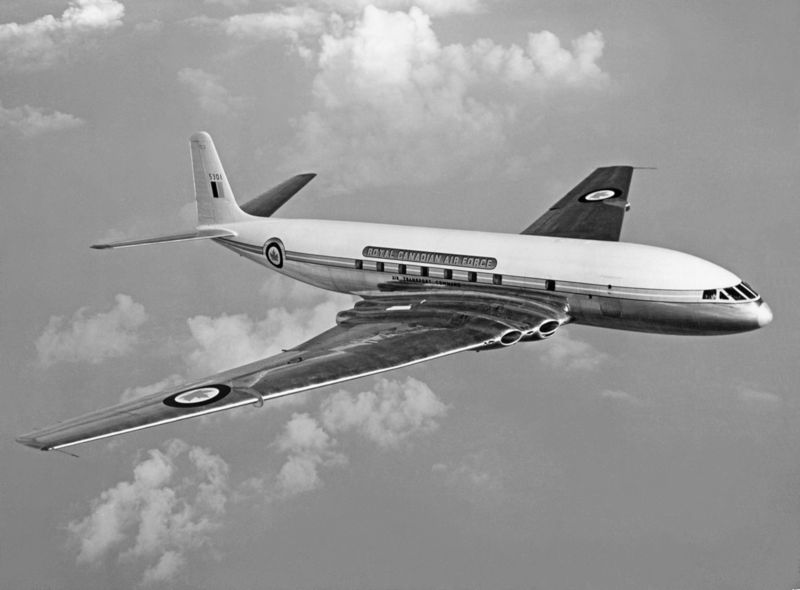
De Havilland was really looking forward to the "Comet 2", however, which was to be fitted with Rolls-Royce Avon axial-flow engines, a generation ahead of the Ghost. The Avon promised higher thrust and lower fuel consumption, reducing the time for hopping across continents even further. The "Comet 2X" prototype performed its first flight on 16 February 1952, fitted with Avon 502 engines providing 29.4 kN (2,995 kgp / 6,600 lbf) thrust each. BOAC requested and got a 91-centimeter (3-foot) fuselage stretch for production machines to add another row of seats. Seven more airlines signed up, significant buyers being Air France (again) and Japan Air Lines, eagerly waiting on delivery. De Havilland was in a crunch for production capacity -- a problem, but one of the best problems to have -- and Shorts in Belfast was brought in to set up a second production line.
De Havilland had even bigger ideas, announcing the "Comet 3" at the 1952 Farnborough Air Show. The Comet 3 was to leverage off more powerful Avon variants to obtain a fuselage stretch of 5.64 meters (18 feet 6 inches) and a passenger capacity of 76 seats. Range was to be increased by over 50%, with new fuel tankage being provided in "pinion tanks", which consisted of a pod extending from the leading edge of the wing near each wingtip. There were many sales inquiries and airlines queued up to buy the aircraft. De Havilland worked to build up a third production line.
The Comet 3 prototype performed its initial flight on 19 July 1954, powered by Avon 523 engines with 44.5 kN (4,535 kgp / 10,000 lbf) thrust each. By that time, six Comet 2s had been built, with one demonstrating the variant's potential by flying direct from London to Khartoum in 6 hours 30 minutes. The world was going to be halved again. Unfortunately, by that time the Comet program was in deep trouble.
* The Comet had suffered accidents, of course; there's never been an aircraft built in numbers that didn't. On 26 October 1952, a BOAC Comet 1 departing from Ciampino airport near Rome ran out of runway on take-off; there were no serious injuries but the Comet was a loss. In March 1952, a Canadian Pacific Airlines Comet 1A being delivered to Australia similarly ran out of runway on take-off at Karachi, Pakistan, with all on board being killed -- somewhat fortunately, it was only carrying six passengers.
The initial judgement on these accidents was that they were due to pilot error, but two accidents following the same pattern was suspicious. Further investigation showed that the Comet could undergo aerodynamic and engine stall at certain angles of attack. The leading edge of the wing was drooped slightly and pilot procedures were revised.
A BOAC Comet 1 crashed in a tropical storm on 2 May 1953 after take-off from Calcutta, India, with all on board lost. The crash was chalked up, without much examination, to bad weather. On 10 January 1954, a BOAC flight out of Ciampino broke up in flight and crashed into the Mediterranean near the island of Elba, again with all on board lost. This disaster set off alarms, since there didn't seem to be any obvious reason for it. The crew never had a chance to report a problem, the aircraft simply disappeared, and it took a Royal Navy salvage crew a month to find the wreckage at the bottom of the sea.
The Comet fleet was grounded while a committee investigated the cause. The committee concluded that the cause of the accident had been an engine fire, and fixes were implemented to reduce the fire hazard. Comet flights resumed on 23 March 1954. However, on 8 April 1954, a Comet on charter to South African Airways was flying from London to Johannesburg when it broke up in flight after a stopover in Rome, crashing in the sea near Naples with all lost. Something seemed to be seriously wrong with the Comet, and the fleet was grounded once again while a more thorough investigation was conducted.
The suspicions focused on fatigue caused by pressurization and depressurization. The cabin pressurization had been put to fairly severe test underwater during development, but that was not the same as enduring hundreds to thousands of cycles of pressurization and depressurization, which could promote mechanical fatigue. A Comet that had already endured over 1,200 pressurization cycles in the course of its flight duties was subjected to 1,800 cycles under artificial conditions on the ground. The square passenger windows turned out to be the weak link: their corners focused stress, and the riveted assembly scheme used with the windows aggravated the damage. The Comet 3 featured oval windows; much pain could have been avoided had the oval windows been implemented from the start, but the designers lacked the benefit of hindsight.
* All export orders for the Comet were canceled, and the Comet 1s and 1As were taken back. The only exceptions were two Comet 1s sold to the RCAF, which were modified with the oval windows and thicker skinning, to be redesignated "Comet 1XB". They were redelivered in 1957 and were operated to 1964. The other Comet 1s and 1As were mostly scrapped, except for a few used in test and trials.
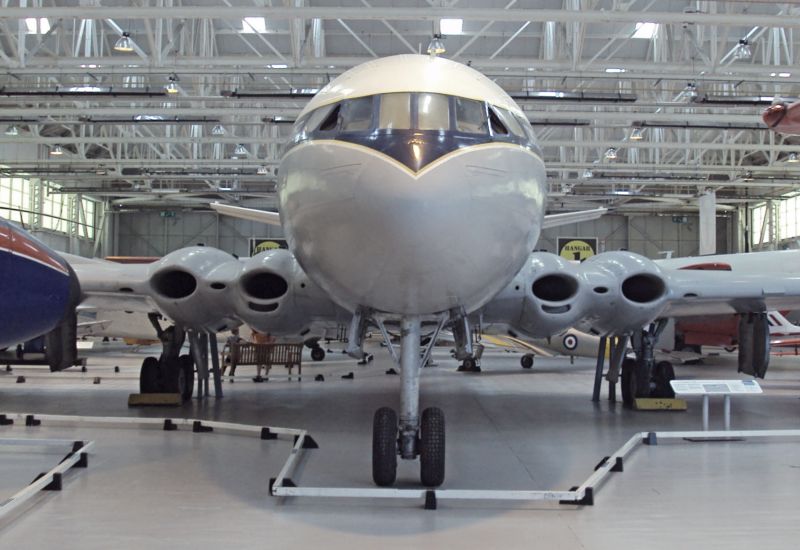
None of the Comet 2s built went into commercial service. Those that had been completed were also rebuilt with oval windows and thicker skin, with additional production to that spec to provide a batch of ten aircraft delivered from the summer of 1956 to RAF Transport Command, under the designation of "Comet C.2". Sources vary on the Avon variant used, but it seems to have been the Avon 503, with 32.5 kN (3,310 kgp / 7,300 lbf) thrust. The Comet C.2s served faithfully up to 1967. Three Comet 2s were also delivered to the RAF, to be fitted with electronics gear and antenna fairings for the "electronic intelligence (ELINT)" mission; they were designated "Comet R.2".
Two other "Comet 2E" machines -- with two Avon 504 engines providing 32.6 kN (3,325 kgp / 7,330 lbf) in the inner positions, and two Avon 524 engines providing 46.7 kN (4,760 kgp / 10,500 lbf) thrust in the outer positions -- served with BOAC for route proving, the two eventually ending up in government test and trials use.
BACK_TO_TOP* The Comet did stage a comeback of sorts after the disasters -- thanks to BOAC, which ordered 19 "Comet 4" jetliners in 1955. The Comet 4 was essentially the production version of the Comet 3, with the stretched fuselage and pinion tanks, the major difference from the Comet 3 being Avon 524 engines. The first Comet 4 performed its initial flight on 27 April 1958, and the Comet 4 became the first jetliner in trans-Atlantic service, performing its initial flight across the ocean on 4 October 1958, beating Pan-American's 707 service across the Pond by 22 days. However, that mostly amounted to a propaganda exercise, BOAC replacing the Comet with the 707 a year later. All the BOAC Comet 4s were sold off by 1965, though they did have fine careers in other hands. Along with the 19 BOAC machines, nine Comet 4s were bought by other airlines, bringing the total produced to 27.
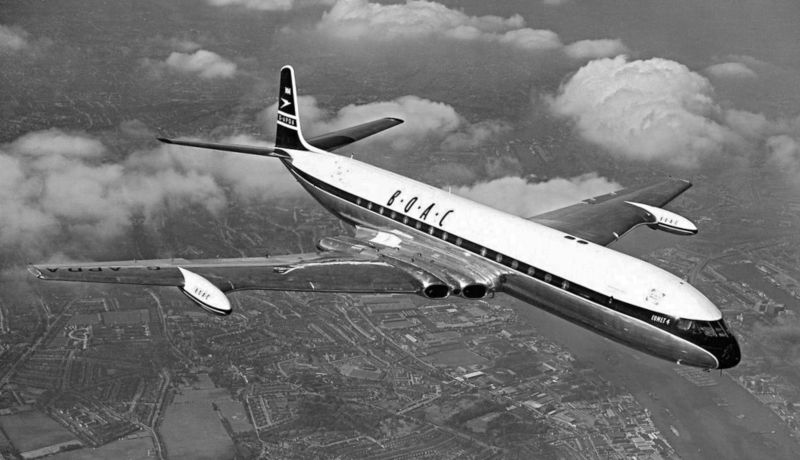
De Havilland worked on a short-haul "Comet 4A" for an American deal, with this variant to feature the Comet 4 fuselage with a clipped wing and no pinion tanks. That deal fell through, but de Havilland went ahead and developed the "Comet 4B" for British European Airways (BEA), this variant being much the same as the Comet 4A except for a further stretched fuselage, with a maximum passenger capacity of 119 seats. It was originally powered by Avon 524 engines, later by Avon 525Bs, featuring improvements but the same thrust rating.
The Comet 3 was rebuilt with the clipped wing to serve as a demonstrator for the Comet 4B, with the rebuild designated the "Comet 3B"; it would go on to further use in test and trials. 18 Comet 4Bs were manufactured in all.
___________________________________________________________________
DE HAVILLAND COMET 4B:
___________________________________________________________________
wingspan:
32.87 meters (107 feet 10 inches)
wing area:
191.3 sq_meters (2,059 sq_feet)
length:
35.97 meters (118 feet)
height:
8.69 meters (28 feet 6 inches)
empty weight:
33,483 kilograms (73,816 pounds)
MTO weight:
73,483 kilograms (162,000 pounds)
cruise speed:
855 KPH (530 MPH / 460 KT)
cruise altitude:
7,165 meters (23,500 feet)
range:
5,390 kilometers (3,350 MI / 2,915 NMI)
___________________________________________________________________
The last Comet variant to be built was the "Comet 4C", which was the Comet 4B fitted with the wide-span wing and pinion tanks of the Comet 4. It was the most heavily produced version, with 30 built. Five went to the RAF for service as the "Comet C.4", usually fitted with 94 backward-facing seats. The backwards seating scheme is common in military transports since it improves passenger survivability in a crash; civil transports rarely use it, since paying customers find it unsettling. The Comet C.4s could also be reconfigured as VIP transports and as air ambulances. Two Comet 4Cs were directly passed on to Hawker Siddeley to be rebuilt into prototypes of the Nimrod ocean patrol aircraft, with one fitted with Spey engines instead of Avons.

The Comet 4 was an excellent aircraft -- but by that time Boeing had developed its 707 jetliner, which dominated the jetliner business. The Comet was never able to regain its initial lead. There was talk of a more capable "Comet 5" with a wider fuselage, greater passenger capacity, and podded engines, but it didn't happen.
The Comet remained in service through the 1960s and 1970s, with Dan-Air of the UK making excellent use of the type. The last commercial passenger flight of a Comet was in 1981. The last flight of a Comet, an aircraft in British government service, was in 1997. The Comet was a classic lost opportunity, an aircraft too advanced for its own good, and an unfortunate testimonial to the saying that pioneers can be recognized by the arrows in their backs.
113 Comets of all types were built. The following list summarizes Comet variants and production:
* The French aviation industry had languished under military occupation during World War II, but in the aftermath of the war, French aircraft producers were energetic, working hard to develop leading-edge aircraft. A jetliner was obviously attractive, and by 1950 various manufacturers were drawing up proposals.
In October 1951, the French Civil Aircraft Committee (CMC in its French acronym) issued a requirement for a medium range airliner, to carry 55 to 65 passengers and a tonne (2,200 pounds) of cargo on routes of up to 2,000 kilometers (1,240 miles) at a cruise speed of 600 KPH (370 MPH). All the major French aircraft manufacturers submitted proposals, with the CMC selecting three finalists in March 1952. In July, the proposal from the Sud-Est company, the "X-210", was accepted for development, with an order placed for two flight prototypes and two static-test airframes at the beginning of 1953.
The X-210 design had originally featured three Rolls-Royce Avon turbojets in the tail, but when it became apparent that Avons with 50% more thrust were to be available in the near future, one of the engines became redundant and was deleted. The snub-nosed appearance of the X-210 suggested the DH Comet. The resemblance was not coincidental: Sud-Est had licensed the design for the forward fuselage from de Havilland.
* The first prototype of the "SE-210 Caravelle" -- the elegant name had been selected by Madame Yvonnne de Gaulle, after the tidy lateen-masted sailing ships the Portuguese had used to explore the world centuries before -- performed its initial flight on 27 May 1955. Pierre Nadot and Andre Moynot were at the controls, with three other crew on board, the aircraft being painted in Air France livery. It was powered by twin Avon RA.26 Mark 522 turbojets with 44.5 kN (4,535 kgp / 10,000 lbf) thrust each, and featured a cargo door on the left side of the fuselage. The second prototype performed its initial flight on 6 May 1956; it was similar to the first, but didn't have a cargo door.
Trials proving successful, the Caravelle was ordered by Air France that same year, 1956, with the Scandinavian Airlines Service (SAS) becoming the second buyer in 1957. Sud-Est merged with competitor Sud-Oeust in 1957 to become "Sud Aviation", but the "SE" designation remained unchanged. The Caravelle was certified in May 1959; service with Air France and SAS began shortly afterwards. The Caravelle was attractive, innovative, and effective, with Sud scrambling to keep up with orders.
* The initial production variant, the "Caravelle I", was similar to the prototypes, except for a 1.5-meter (5-foot) fuselage stretch and a tailfin extension that housed a radio antenna. The Caravelle I featured RA.29/1 Avon Mark 522 turbojets -- with the same thrust as the Avons used in the prototypes, but with technical improvements -- and up to 80 passenger seats in a five-across format, or 64 in a four-across format. There were two toilets in the rear, with galleys fore and aft. There was a passenger door on the forward left fuselage, a service door at the same location on the right, two emergency exits over each wing, and drop-down "airstair" passenger door under the tail -- allowing passengers to get in and out without roll-up stairs.
The Caravelle I was a sleek and futuristic design in its era, more the image of the future of the jetliner than the Comet. It was of all-metal construction, with swept wings and swept tail surfaces. The wings had a sweep of 20 degrees, a dihedral of 3 degrees, and there were twin wing fences on each wing. There were two-piece ailerons; flaps; and airbrakes above and below the wing in front of the flaps. The tail-mounted engine scheme provided easy service access to the engines, reduced cabin noise, and provided a little safety margin in case of an engine fire. The landing gear arrangement was somewhat like that of the Comet -- twin-wheel nose gear retracting backwards, and four-wheel main gear in a 2x2 bogie arrangement, retracting inward (not outward as with the Comet) from the wings.
A total of 20 Caravelle Is was built, ten going to Air France, six going to SAS, the other four being split between the national airlines of Algeria and Brazil. The Caravelle I was followed by the "Caravelle IA", which was generally identical but featured further improved Avon RA.29/1 Mark 522A engines. Initial flight was on 11 February 1960, with 12 built, users including Air France, SAS, and three other airlines.
* Introduction of the significantly uprated Avon RA.29/3 Mark 527, with 50.7 kN (5,170 kgp / 11,400 lbf) thrust, led to the "Caravelle III" -- there was no Caravelle II, the "III" reflected the Avon "Mark 3" engine variant. Initial flight was on 30 December 1959. It was the most heavily produced Caravelle variant, with 79 built, more than half going to Air France, which used them on European routes up to 1981, replacing them with Boeing 727s and 737s. Other users included SAS, Alitalia, and Swissair.
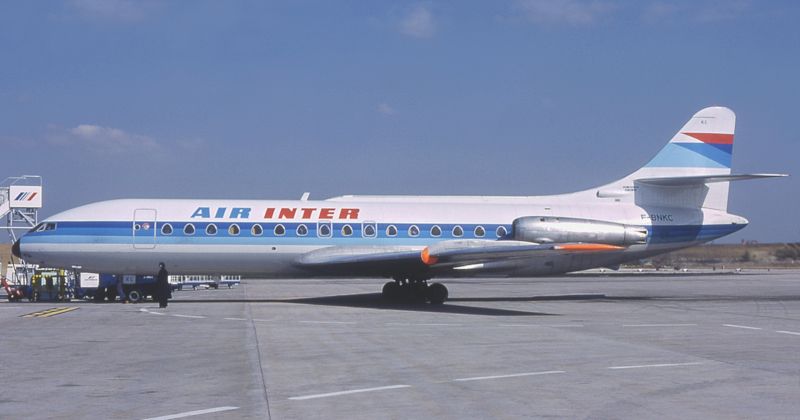
All 31 surviving Caravelle I/IA machines were upgraded to Caravelle III spec, which required fitting enlarged nacelles along with the new engines. Two Caravelle IIIs were purchased by the Flygvapnet, the Swedish Air Force, from SAS in 1971, being converted to an ELINT configuration and designated "Tp85".
___________________________________________________________________
SUD AVIATION CARAVELLE III:
___________________________________________________________________
wingspan:
34.3 meters (112 feet 6 inches)
wing area:
146.7 sq_meters (1,579 sq_feet)
length:
32.01 meters (105 feet)
height:
8.72 meters (28 feet 7 inches)
empty weight:
24,185 kilograms (53,318 pounds)
MTO weight:
46,000 kilograms (101,410 pounds)
max cruise speed:
805 KPH (505 MPH / 435 KT)
take-off field length:
1,830 meters (6,000 feet)
landing field length:
1,800 meters (5,900 feet)
service ceiling:
12,000 meters (39,370 feet)
range:
1,845 kilometers (1,155 MI / 1,000 NMI)
___________________________________________________________________
Incidentally, photos of the Caravelle III typically show it to have had a slender fairing on top of the fuselage, running from the tailfin to just short of the front of the wings. Apparently, the fairing accommodated avionics; the puzzle is that not all Caravelle variants had the fairing, and it isn't clear if the fairing was common to all examples of a specific variant either.

The "Caravelle VIN" featured further uprated Avon RA.29/6 Mark 531 or Mark 531B engines, with 54.3 kN (5,535 kgp / 12,200 lbf) thrust and noise suppression exhausts. It also featured a modified cockpit with larger side windows and spoilers / lift dumpers on the outer wings. Initial flight was on 10 September 1960. 53 were built new, with five Caravelle IIIs upgraded to the same configuration.
The Caravelle VIN was built in parallel with the "Caravelle VIR", one of the first commercial jetliners to be fitted with thrust reversers. Powerplants were Avon RA.29 Mark 533R or Mark 535R turbojets with 56.2 kN (5,725 kgp / 12,625 lbf) thrust each, the "R" indicating the thrust reverser capability. The Caravelle VIR also featured spoilers / lift dumpers, larger cockpit windows, and stronger brakes. Initial flight was on 6 February 1961, with 56 built. 20 were sold to United, the Caravelle's only direct sale to a US airline, with these machines remaining in American service until 1970, when they were parked and then sold off to other airlines. The Caravelle VI series also proved popular with South American operators.
* The "Caravelle VII" was to be a Caravelle III fitted with General Electric (GE) CJ805-23 turbofans, the CJ805 being a derivative of the popular GE J79 military afterburning turbojet. A GE-engined Caravelle was regarded as a way to enter the US jetliner market, with TWA expressing interest. A Caravelle III was appropriately re-engined by GE, but TWA decided to acquire the Douglas DC-9 instead.
BACK_TO_TOP* Although the Caravelle VII went nowhere, Sud Aviation remained interested in alternate engine fits, resulting in the "Caravelle 10A" or "Caravelle Horizon". It featured CJ805-23C turbofans and a fuselage stretch of a meter (39 inches), providing a passenger capacity of 105 seats. The windows were shifted upwards by 20 centimeters (8 inches), and an auxiliary power unit (APU) was fitted in the rear fuselage. The wing was modified slightly, with improved flaps. Initial flight of the Caravelle 10A prototype was on 31 August 1962.
The Caravelle 10A didn't go into production, with Sud Aviation moving on to the further refined "Caravelle 10B", AKA "Super Caravelle" or "Super B". It featured a fuselage stretch of a meter -- from 32.01 meters (105 feet) to 33.01 meters (108 feet 4 inches), providing a maximum passenger capacity of 104 seats -- and added a "leading edge extension" to the wing to provide better controllability at high angles of attack; split flaps were fitted as well. The Super B also significantly adopted the Pratt & Whitney (P&W) JT8D-7 turbofan, with 62.3 kN (6,350 kgp / 14,000 lbf) thrust. Initial flight was on 3 March 1964.
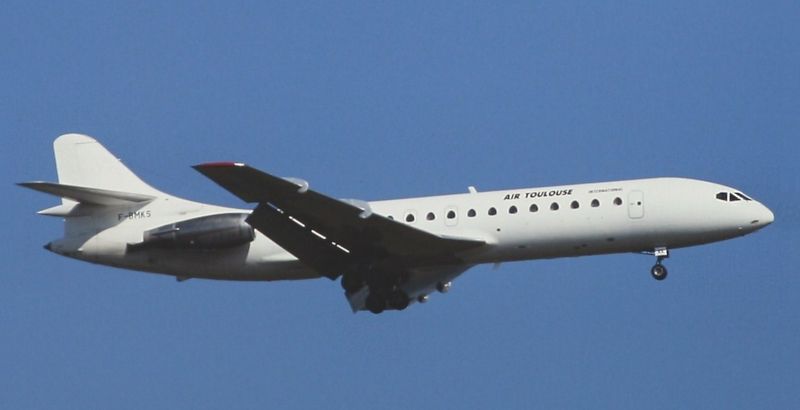
Some sources suggest the longer fuselage and wing extensions were trialed on the Caravelle 10A, and that Caravelle 10B production was split between aircraft with thrust reversers and aircraft without, but the specifics are unclear and confusing. A total of 22 Super Bs was built, with Finnair being the biggest user, buying eight.
The "Caravelle 10R" was effectively a Caravelle VI-R with JT8D turbofans. Passenger capacity remained the same, but the higher thrust meant that maximum take-off weight increased by 2,000 kilograms (4,400 pounds). Initial flight was on 8 January 1965, with 20 built.
The "Caravelle 11R" was what would now be called a "combi" machine, capable of handling both cargo and passengers. It featured a fuselage stretch relative to early Caravelle variants of 70 centimeters, giving it a length of 32.71 meters (107 feet 4 inches) -- slightly less than the Caravelle 10B. It also had a large cargo door on the forward left fuselage. In all-passenger configuration, it had a maximum capacity of 99 seats; in all-freight configuration, it had a max payload of over 9 tonnes (10 tons) in a cargo hold with a volume of 115 cubic meters (4,061 cubic feet). Initial flight was on 21 April 1967. Only six were built.
The "Caravelle 12" was the ultimate Caravelle. It featured a fuselage stretch of 3.23 meters (10 feet 7 inches) relative to the Caravelle 10B, giving a total length of 36.24 meters (118 feet 10 inches). It was powered by uprated JT8D-9 turbofans with 64.5 kN (6,575 kgp / 14,500 lbf) thrust each. It could carry up to 140 passengers and was targeted at the charter market. Initial flight was on 12 March 1971, with a dozen built.

* Caravelles served in a dwindling fashion to the end of the 20th century. 282 Caravelles of all types were built, the following list giving variants and production:
It is unclear if any Caravelles still flying, but a number of them survive as static displays. The Caravelle was an early success for European jetliner manufacturers, a bright spot in decades of domination by American jetliner giant Boeing, until the emergence of Airbus Industries provided an effective challenge.
* Sources include:

* Revision history:
v1.0.0 / 01 jan 09 v1.0.1 / 01 dec 10 / Proofing & cleanup. v1.0.2 / 01 nov 12 / Review & polish. v1.0.3 / 01 oct 14 / Review & polish. v1.0.4 / 01 sep 16 / Review & polish. v1.0.5 / 01 aug 18 / Review & polish. v1.0.6 / 01 jul 20 / Review & polish. v1.1.0 / 01 may 22 / Illustrations update. v1.1.1 / 01 apr 24 / Review & polish.BACK_TO_TOP
